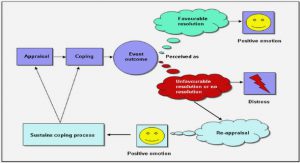Get Complete Project Material File(s) Now! »
Hydration process of cement
Portland cement is the most commonly used cement and consists mainly of the four compounds alite (C3S), belite (C2S), aluminate (C3A) and ferrite (C4AF) [1].
Table 2.1 shows the oxide composition and the respective abbreviations with the cement chemist notation (CCN). The CCN notations use one letter for each oxide, i.e. C = CaO, S = SiO2, A = Al2O3 and F = Fe2O3. Similarly, the notation for water is H. The reaction of the compounds in Table 2.1 with water, the so called hydration process, creates the hardened cement paste [5]. The reaction is roughly described according to Gasch [1] with the Eq. (2.1) – (2.3) where Eq. (2.1) and (2.2), containing the calcium silicates, describes the major part of the behavior.
Heat of hydration
The heat development is governed by the hydration of cement and hence dependent on the cement content [9]. Generally, a higher cement content causes increased heat development. A report from the American Concrete Institute [11] states that the hydration of cement increases the temperature in the concrete by roughly 5 – 7 °C for every 50 kg=m3 of cement content. In the case of having concretes with the same cement content but different w/c ratios, the concrete with the higher w/c ratio would have a higher rate of heat development. This is because more water is available for the cement to react with which also increases the rate of hydration.
Figure 2.3 shows the effect of different w/c ratios on the heat evolution. The effect on the rate of heat development by increasing the cement content is more significant than the same effect from a higher w/c ratio. The heat generation also increases by lowering the w/c ratio as a result of increasing the cement content. The rate of heat generation is also influenced by the cement composition. Higher contents of tricalcium silicate (C3S) and tricalcium aluminate (C3A) in the cement increases the rate of heat generation. Cements that have higher fineness have higher rate of heat generation than other cements.
Thermal properties and heat transfer
The thermal properties of the concrete is partly affected by the environmental factors, which includes e.g. ambient – and casting temperatures and wind speed, respectively.
In addition, external factors such as form material and type of insulation could play a decisive role as well.
The thermal properties affected includes e.g. thermal conductivity, heat capacity, heat transfer coefficient and coefficient of thermal expansion, respectively. The thermal conductivity, k, represents the ability of the material to transmit heat.
This property is dependent on the moisture content and type of aggregate, where the conductivity decreases with decreasing moisture content. The heat capacity, Ct, describes the amount of heat necessary to increase the temperature with one degree in the material. As opposed to the thermal conductivity, the heat capacity increases with increasing moisture content and temperature [1]. The heat transfer coefficient, h, describes the heat exchange due to convection and depends on the wind speed for surfaces exposed to air [14]. The coefficient of thermal expansion, CTE, describes the materials propensity to change in volume due to a change in temperature. However, it is necessary to describe the coefficient of thermal expansion of the concrete as a function of both the coefficients for the cement paste and aggregates since these are usually different.
Thermal cracks and restraint
As a consequence of the heat generated during the hydration process, the temperature in a new concrete structure rises while it simultaneously expands. After some time, the heat generation decreases following a natural cooling and contraction of the concrete as shown in Figure 2.4.
Cooling and heating
To eliminate cracks and other durability problems, the most important factor is to control the temperature during the curing of the concrete [18]. For this, there are several methods depending on the size and requirements of the project.
To keep the temperature at a lower magnitude, one option is to cool the concrete, which could be achieved in different ways. For instance, the aggregates could be cooled prior to mixing. One option is to spray the coarse aggregates with chilled water while the finer aggregates could be placed in a tank and cooled with cold air. The water that is used for the mixing could be cooled as well, either separately or combined with ice [19]. When acting on one of these options prior to mixing, especially if cooled water or ice are used, one needs to always take the w/c ratio into account. Adding water to the mix in an uncontrolled way could create durability problems in the concrete. The use of cooling pipes is a common option as well, especially since no additional ingredients in the recipe are required. Cooling pipes are embedded in the formwork and when the concrete is casted, a cooling media is allowed to flow through the pipes to keep the temperatures down. Although cooled air could be used, the diameter of the pipes would have to be increased to have an effect, making it a less popular option.
Another option to minimize the risks of cracks for a new structure is to pre-heat adjacent structures with heating cables which decreases the usually large temperature difference in the concrete. In addition, the similar effect could be obtained by using insulation in the formwork.
The heat development can be reduced by lowering the cement content and replacing some of it with additives [9]. Fly ash can for instance reduce the rate of heat development significantly [12]. The effects of the cooling methods on the temperature development are shown Figure 2.6.
Mechanical properties
The development of mechanical properties includes the compressive strength, tensile strength and elastic modulus, respectively, and they are necessary to predict and model for assessment of early age concrete. Although all of these increase as the hydration proceeds, they do so at different rates.
The main purpose of concrete structures is to carry compressive forces. Hence, the compressive strength is the most important and most studied property of concrete. The development of the compressive strength for different cement finenesses are shown in Figure 2.10. Other than the varied cement fineness, the recipes of the different concrete used in the experiment are identical. It can be concluded that a higher rate of cement fineness generates higher compressive strength [24]. In addition, it has an effect on workability of the fresh concrete, as mentioned in Section 2.3.1.
Shrinkage and swelling
Shrinkage is a term that sometimes is divided into many parts. However, according to Eurocode 2, the total shrinkage strain is the sum of the drying shrinkage strain and the autogenous shrinkage strain.
Drying shrinkage occurs as a slow process due to the loss of water from the concrete and continues many years after the concrete has hardened [1]. This mainly occurs due to withdrawal of stored water in unsaturated air from the hardened concrete [5].
The effect of this can be seen in Figure 2.12. It can be concluded that, for concrete that has been allowed to dry in air at a certain relative humidity and then placed in water (or at a higher humidity), it will swell. Swelling is a process that describes a volume expansion due to continuous supply of water during the hydration. However, not all of the initial drying shrinkage is recovered, i.e. there is a certain irreversible shrinkage.
Creep
Initially, when a first stress is applied on a concrete structure, it shows an elastic behavior, which is described by the elastic strain. Creep is defined as the increase in strain under a sustained constant stress, after other time dependent deformations (e.g. shrinkage and swelling) has been accounted for [5]. Depending on the ambient temperature, creep is normally divided into basic – and drying creep [24]. Basic creep occurs when there is no moisture exchange between the concrete and the environment. It can be divided into two stages, short-term and long-term basic creep. For early age concrete, the short-term basic creep is important since it is partly affected by the hydration. This is due to the volume growth created by the hydrated products in the capillary pores that leads to a decrease of creep with loading time [1]. Drying creep is defined as the additional deformation (after subtraction of the pure drying shrinkage and thermal deformations) caused by drying or elevated temperatures [1].
Table of contents :
1 Introduction
1.1 Background
1.2 Aim and research questions
1.3 Limitations
1.4 Outline of the report
2 Early age concrete
2.1 Hydration process of cement
2.1.1 Aging of concrete
2.2 Temperature development
2.2.1 Heat of hydration
2.2.2 Thermal properties and heat transfer
2.2.3 Thermal cracks and restraint
2.2.4 Cooling and heating
2.3 Strength development
2.3.1 Fresh concrete
2.3.2 Cement compounds
2.3.3 Mechanical properties
2.4 Time dependent deformations
2.4.1 Shrinkage and swelling
2.4.2 Creep
3 Mathematical modelling in ConTeSt
3.1 Heat of hydration
3.2 Heat flow
3.2.1 External boundary conditions
3.2.2 Internal boundary conditions
3.3 Mechanical properties
3.3.1 Strength growth
3.3.2 Stress development
4 Case study of a massive concrete wall
4.1 The power station of Storfinnforsen
4.1.1 The bottom outlets
4.2 The new wall
4.2.1 Design procedure
4.2.2 Practical procedure and technical data
4.3 Numerical model
4.3.1 Model and material definitions
4.3.2 Boundary conditions
4.3.3 Convergence analysis of the element size
4.4 Material tests
5 Results and discussion
5.1 Sensitivity analysis
5.1.1 Effects from the cement content
5.1.2 Effects from the ambient temperature
5.1.3 Effects from the wind speed
5.1.4 Effects from the degree of restraint
5.1.5 Combination of factors
5.2 Crack risk analysis
6 Measurement plan
6.1 Suggested placement of measuring equipment
6.2 Method of monitoring and instrumentation
6.2.1 Measuring equipment
6.2.2 Data acquisition
7 Conclusions and further research
Bibliography






